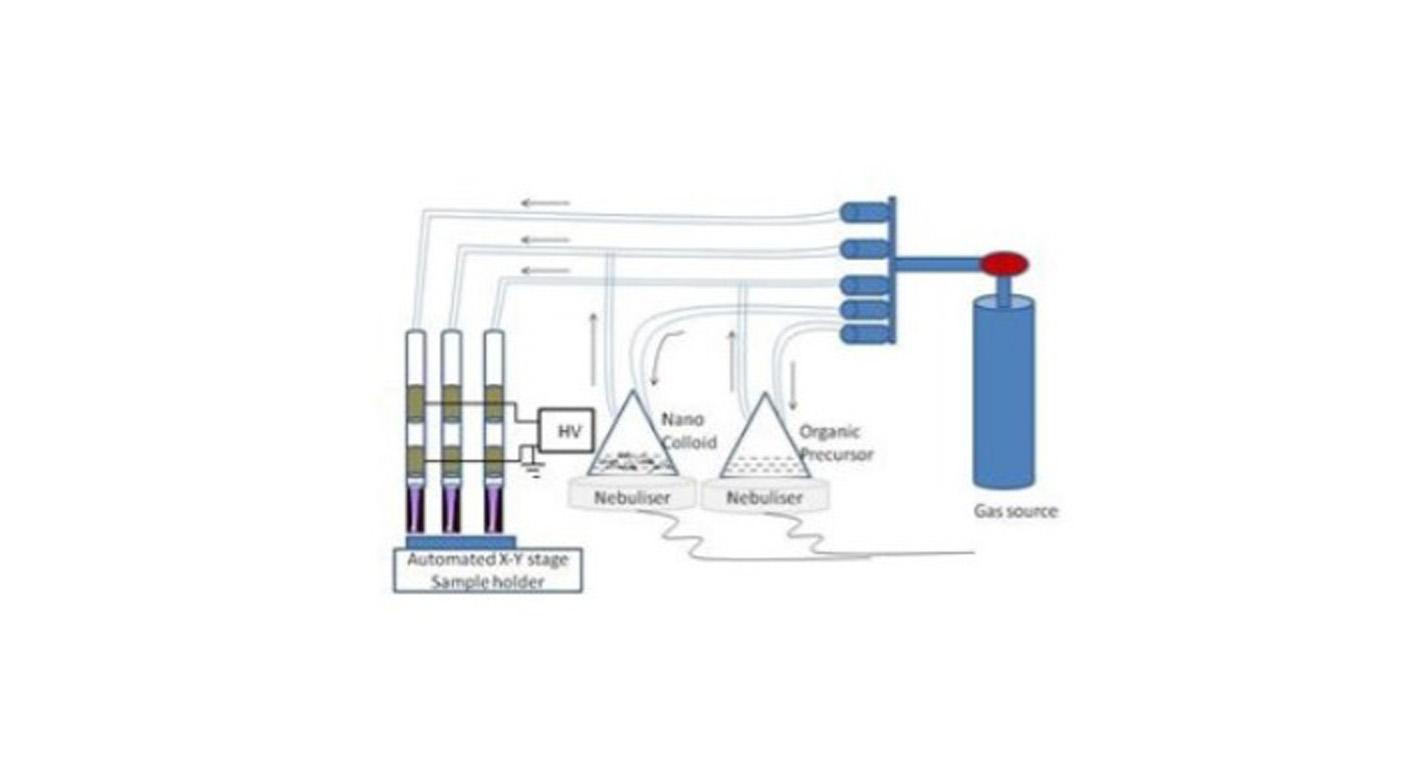Fabricating printable electronics and biosensor chips
manufacturing
Fabricating printable electronics and biosensor chips (TOP2-218)
Atmospheric Pressure Plasma Based Fabrication of Printable Electronics and Functional Coatings
Overview
NASA has developed a unique approach for an atmospheric pressure plasma-based process for fabrication of printable electronics and functional coatings. The need for low-cost and environmentally friendly processes for fabricating printable electronics and biosensor chips is rapidly growing. This plasma-based fabrication involves aerosol-assisted room temperature printing in which an aerosol carrying the desired material for deposition is introduced into a cold plasma jet operated at atmospheric pressure. The deposition is the result of the interaction of the aerosol containing the precursor material with the atmospheric pressure plasma containing a primary gas. Aerosol-assisted plasma deposition is a high throughput and facile process for printing and patterning that is easily scalable for industrial production. Multiple jets can be used for depositing different materials and the approach can be adapted to a variety of platforms and coating a variety of materials.
The Technology
The plasma system consists of a glass tube with a diameter of 0.5 mm or larger, if desired. The electrodes are separated by 10 mm. Helium, argon or cold dry air can be used as a plasma gas source. An applied high voltage between the electrodes causes the gas to breakdown within the central core of the glass capillary generating atmospheric plasma. Nanostructures colloids/organic/inorganic precursors are placed in a glass container with an inlet and outlet for carrier gas and are seated on an ultrasonic nebuliser. The aerosol is then carried into the plasma stream by the carrier gas and is deposited.
The atmospheric plasma deposition system can be modified for depositing multiple materials, either simultaneously or sequentially, and for high-throughput processing by having multiple jets. Each capillary can either be connected to the container containing a single precursor material or to different containers containing different precursor materials to facilitate multiple depositions. The multi-jet plasma system can be automated and controlled individually to precisely control surface characteristics. This technique is independent of the chosen substrate, and has proven to work for many substrates, including paper, plastic, semiconductors and metals.

Benefits
- Low-cost manufacturing of printed electronics/biosensor chips
- Easily scalable for industrial production
- Works in microgravity
- Adapts to a variety of materials and substrates including flexible substrates
Applications
- Biomedical technology
- Consumer electronics, e-paper
- Intelligent / Security
- Communications
|
Tags:
|
Similar Results

Conductive High-Toughness Oxides
Oxide coatings have been used in thermal and environmental barrier layers for coatings for hot section turbine applications, among other uses. With the PS-PVD method, Glenn researchers observed the formation of a minority phase of a metastable oxide (zirconium oxide) that is usually found only in a vapor state. They found that the high temperatures and fast deposition process of the PS-PVD system incorporated nonequilibrium phases in the coating and retained them at room temperature as well as at high temperature in the absence of oxygen. The material is vaporized and condensed on the surface via a rapid quenching, essentially "trapping" this phase in the deposited coating. The coating microstructure and composition can also be manipulated by changing the processing parameters, allowing the thickness of the coating to be tailored to a given application. Since this metastable phase is conductive, this coating can be used as (for example) an extremely sensitive (thermal or temperature) sensor. It also has very good durability and erosion resistance, making it useful as a protective and conductive coating for electronics and microelectronics. This is an early-stage technology requiring additional development, and Glenn welcomes co-development opportunities.

Composite Dielectric Inks for Humidity Sensing
The NASA technology is based on a perovskite ceramic developed at MSFC, reduced lanthanum barium titanate (rLBT). rLBT is comprised of reduced barium titanate (BaTiO3) doped with lanthanum (La) and co-doped with potassium hydroxide (KOH). rLBT was developed while exploring the suitability of sintered perovskites to produce screen-printed ultracapacitors; the prototypes unexpectedly demonstrated an extreme sensitivity to moisture, prompting exploration of the material for use as a vapor-sensitive dielectric ink.
To eliminate inconvenient high temperature firing necessary to produce capacitors, the inventors developed rLBT-loaded polymer composites capable of curing under low heat (110 degrees C) for epoxy or under ultraviolet (UV) light for UV-sensitive resin. At suitable ceramic particle loading concentrations, thin ink layers (30 micrometers) demonstrate RH sensitivity, instantaneously detecting breath vapor (RH change from 30% to 93%) with a recovery time of only 1s. Prototypes demonstrated near log-linear response curves over three orders of magnitude of capacitance with minimal drift (see Figures 1 and 2).
NASA’s low temperature dielectric ink for humidity sensing is at technology readiness level (TRL) 4 (component performance has been validated in a lab setting) and the related patent is now available to license. Please note that NASA does not manufacture products itself for commercial sale.

Cryogenic Flux Capacitor
Storage and transfer of fluid commodities such as oxygen, hydrogen, natural gas, nitrogen, argon, etc. is an absolute necessity in virtually every industry on Earth. These fluids are typically contained in one of two ways; as low pressure, cryogenic liquids, or as a high pressure gases. Energy storage is not useful unless the energy can be practically obtained ("un-stored") as needed. Here the goal is to store as many fluid molecules as possible in the smallest, lightest weight volume possible; and to supply ("un-store") those molecules on demand as needed in the end-use application. The CFC concept addresses this dual storage/usage problem with an elegant charging/discharging design approach.
The CFC's packaging is ingeniously designed, tightly packing aerogel composite materials within a container allows for a greater amount of storage media to be packed densely and strategically. An integrated conductive membrane also acts as a highly effective heat exchanger that easily distributes heat through the entire container to discharge the CFC quickly, it can also be interfaced to a cooling source for convenient system charging; this feature also allows the fluid to easily saturate the container for fast charging. Additionally, the unit can be charged either with cryogenic liquid or from an ambient temperature gas supply, depending on the desired manner of refrigeration. Finally, the heater integration system offers two promising methods, both of which have been fabricated and tested, to evenly distribute heat throughout the entire core, both axially and radially.
NASA engineers also applied the CFC to a Cryogenic Oxygen Storage Module to store oxygen in solid-state form and deliver it as a gas to an end-use environmental control and/or life support system. The Module can scrub out nuisance or containment gases such as carbon dioxide and/or water vapor in conjunction with supplying oxygen, forming a synergistic system when used in a closed-loop application. The combination of these capabilities to work simultaneously may allow for reduced system volume, mass, complexity, and cost of a breathing device.

Oil-Free Lubricants
In applying PS400 using the plasma spray-coating process, a 0.010 inch layer is deposited onto a metal surface. This composite coating often includes a metallic-based binder, a metal-bonded hardener, a high-temperature lubricant, and/or a low- temperature lubricant. PS400's improved metallic-based binder alloy greatly increases the structural strength and durability of the composite with respect to the operating temperature and the bearing load, and provides superior dimensional stability. PS400's metal-bonded oxide hardening agent provides additional hardness, wear resistance, and thermal stability, while also exhibiting a low coefficient of friction when used in sliding contacts. It is also significantly less expensive in terms of both acquisition and grinding processes.
Depending on the desired environment, high- and low-temperature lubricants may be added to the composite coating. The preferred high-temperature lubricant is a metal fluoride and the optional optional low-temperature lubricant is composed of metals, such as silver or copper, that are soft enough to provide lubrication at low temperature while maintaining oxidation resistance with a sufficiently high melting point. These qualities permit the materials to be used over a broad temperature range. Once the spray coating has been applied, the metal surface is ground and polished to produce a smooth, self-lubricating surface before use. Unlike some coatings that must be diamond-ground, PS400 is readily ground with a substantially less expensive abrasive, such as silicon carbide. This grinding process generally yields a coating thickness of 200 to 400 micrometers.
In instances when a coating is not convenient or possible, powder metallurgy techniques using PM400 can be used to make freestanding self-lubricating components such as bushings and wear plates.
Printable Heat Shield Formulations Advance Spacecraft Construction
One inner insulative layer, and one outer robust ablative layer comprise the AMTPS technology. When applying the heat shield to the surface of a spacecraft, the insulative layer is printed first and primarily functions to reduce the amount of heat soak into the vehicle. The formulation of the insulative layer has a slightly lower density (as compared to the robust layer) and is adjusted using a differing constituent ratio of phenolic and/or glass microballoon material. Both formulations combine a phenolic resin with various fillers to control pre- and post-cure properties that can be adjusted by varying the carbon and/or glass fiber content along with rheology modifiers to enhance the fluid flow for deposition systems.
The robust layer is applied next and functions as the ablative layer that ablates away or vaporizes when subjected to extremely high temperatures such as those achieved during atmospheric entry. The formulation of the robust layer produces a gas layer as it vaporizes in the extreme heat that acts as a boundary layer. This boundary prevents heat from further penetrating the remaining robust material by pushing away the even hotter shock layer. The shock layer is a region of super-heated compressed gas, positioned in front of the Earth-facing bottom of the spacecraft during atmospheric entry, that results from the supersonic shockwave generated.
Commercial space applications for this AMTPS technology include use on any spacecraft that transits a planetary or lunar atmosphere such as Mars or Saturn’s moon Titan. Additionally, the invention may be useful for launch system rockets to provide heat shielding from atmospheric reentry or to protect ground equipment on the launch pad from rocket exhaust plumes. As the number of government and commercial space missions to primary Earth orbits, the Moon, and the Solar System increase, there will be a growing need for cost-effective, on-demand, and timely fabrication of heat shields for space-related activities.
AMTPS Formulations – Insulative and Robust Variation is at a technology readiness level (TRL) 5 (component and/or breadboard validation in laboratory environment) and is now available for patent licensing. Please note that NASA does not manufacture products itself for commercial sale.



